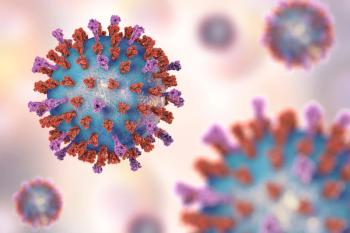
Pharmacy Practice in Focus: Health Systems
- September 2022
- Volume 11
- Issue 5
Immune Thrombocytopenia Purpura Treatment Options Abound
Key Takeaways
- Thrombocytopenia results from various conditions, including autoimmune disorders, cancer treatments, and medications, leading to increased bleeding risk.
- Immune thrombocytopenia (ITP) involves autoantibodies against platelets, classified into acute, persistent, and chronic types, affecting treatment decisions.
Corticosteroids are first-line therapy for gaining platelet stability but should only be used short term.
Thrombocytopenia is a condition characterized by a low platelet count, which are specialized cells in the blood that play a critical role in clotting.1 When the platelet count falls below the desired range, it increases an individual’s risk of bleeding and bruising. Fatigue, hospitalization, impaired quality of life, and even death can occur when thrombocytopenia is severe.
A normal platelet count ranges between 150,000 and 400,000/mm3 (150 to 400 × 109/L).2 Thrombocytopenia is defined as a platelet count of less than 150,000/mm3 (150 × 109/L). If the platelet count is between 70,000 and 150,000/mm3(70 and 150 × 109/L), thrombocytopenia is classified as mild. However, if the platelet count is less than 20,000/mm3 (20 × 109/L), it is severe and can complicate outcomes. The clinical significance of mild thrombocytopenia is minimal and usually does not interfere with clinical management. Patients are commonly asymptomatic when the count is above 50,000/mm3 (50 × 109/L), but they may experience spontaneous or life threatening bleeding if the platelet count falls below 20,000/mm3 (20 × 109/L).2,3
A wide range of conditions, including alcohol use disorder, autoimmune disorders, bone marrow diseases, cancer treatments, enlarged spleen, exposure to toxic chemicals, pregnancy, and viral infections, can cause thrombocytopenia. Medications can also cause thrombocytopenia, including anticoagulants such as heparin, certain chemotherapy agents, furosemide, linezolid, penicillin, nonsteroidal anti-inflammatories, quinidine, quinine, and valproic acid.3 In rare cases, thrombocytopenia is inherited. All cases of thrombocytopenia follow 1 of 3 mechanisms: accelerated destruction of platelets, decreased or ineffective production of platelets in the bone marrow, or splenic platelet sequestration.2-4
Immune thrombocytopenia, also called immune thrombocytopenic purpura (ITP), is acquired when autoantibodies form against platelet antigens.1 The American Society of Hematology (ASH) defines ITP as isolated thrombocytopenia (platelet count < 100,000/mm3) with normal white blood cells and normal hemoglobin in the setting of a generalized purpuric rash. ITP was previously known as idiopathic thrombocytopenic purpura. ITP without a secondary cause or underlying disorder is known as primary ITP. Secondary ITP is defined as ITP with an underlying cause or disorder, which can include drug induced, systemic illness–induced, or viral infection.1,5,6
ITP affects 2 to 5 per 100,000 individuals annually and is divided into 3 types.7,8 These types are determined by time since diagnosis, which is often a factor in treatment decisions. They include the following:
• Newly diagnosed or acute: diagnosis less than 3 months
• Persistent ITP, lasting 3 to 12 months after diagnosis
• Chronic ITP, lasting more than 12 months after diagnosis
ITP must be distinguished from other causes of thrombocytopenia, which may have similar presentations but require different management approaches. It is also vital to evaluate whether ITP is primary or secondary to the underlying condition.
Treatment Options
Although there is no established cure for ITP, platelet counts usually improve with treatment.5 The treatment for acute ITP usually starts with corticosteroids. Because of adverse effects, such as insomnia, mood changes, and weight gain, ASH recommends using steroids for no more than 6 weeks. If platelet counts do not improve with corticosteroids or if a patient presents with bleeding, intravenous immunoglobulin is an option to raise platelet counts quickly.5
There are several options for treatment of chronic or persistent ITP. Thrombopoietin receptor agonists (TPO-RAs) stimulate the body’s production of platelets by megakaryocytes in the bone marrow, which release proplatelets that mature into platelets. There are 3 recommended TPO-RAs, and ASH encourages the use of TPO-RAs before other treatments for chronic or persistent ITP.5,6,8 These include the following:
• Avatrombopag (Doptelet): a once-daily oral tablet with food for adults with chronic ITP who have had insufficient response to a previous treatment
• Eltrombopag (Promacta): a once-daily oral tablet or suspension approved for individuals aged 1 year and older
• Romiplostim (Nplate): a weekly injection approved for individuals aged 1 year and older
The kinase inhibitor fostamatinib disodium hexahydrate (Tavalisse), blocks the action of spleen tyrosine kinase in macrophages to inhibit downstream signaling in ITP.5,8 It is approved for use in adults with chronic ITP who have not responded to previous treatment. Adverse effects include abnormal liver tests, diarrhea, headache, and hypertension, but one advantage is that this drug has the least risk of thrombosis of any licensed treatment of ITP.
Rituximab (Rituxan) is a mono-clonal antibody that reduces IgG antibody production. Although rituximab is part of the ASH guidelines, it is not an FDA-approved treatment for chronic or persistent ITP.5,8 Approximately half of patients respond initially, but just 20% to 30% are cured in long-term outcome studies.
Splenectomy is another treatment option for some individuals with chronic or persistent ITP. However, there is no test to show whether a splenectomy will work, and there are always risks with surgical procedures. Most guidelines recommend deferral of splenectomy for a year from diagnosis to determine whether a patient will go into remission.5 However, splenectomy remains an option for patients who do not succeed using other forms of treatment or in underserved areas, where more expensive alternatives are not available.
A small percentage of patients do not respond to or tolerate first- or second-line treatments. For those patients, medications such as azathioprine, cyclo-phosphamide, cyclosporine, danazol, dapsone, mycophenolate mofetil, and vinca alkaloids may be viable options.9
Finally, the FDA granted the drug rilzabrutinib fast track designation for treatment of ITP in November 2020 after previously granting an orphan drug designation. Rilzabrutinib is an oral, reversible, covalent inhibitor of Bruton tyrosinekinase (BTK).10
LUNA 3, a recent multicenter phase 1/2 dose-finding study (NCT04562766) showed promising results in adults with heavily pretreated ITP.11 This new type of BTK inhibitor reduces macrophage activity and the production of antiplatelet antibodies but does not affect the function of platelets. So far, study results have shown that treatment with rilzabrutinib led to a lasting, rapid increase in platelet count.10 ■
References
1. Cines DB, Blanchette VS. Immune thrombocytopenic purpura. N Engl J Med. 2002;346(13):995-1008. doi:10.1056/NEJMra010501
2. Rodeghiero F, Stasi R, Gernsheimer T, et al. Standardization of terminology, definitions and outcome criteria in immune thrombocy-topenic purpura of adults and children: report from an international working group. Blood. 2009;113(11):2386-2393. doi:10.1182/blood-2008-07-162503
3. Gauer RL, Braun MM. Thrombocytopenia. Am Fam Physician. 2012;85(6):612-622.
4. Nugent D, McMillan R, Nichol JL, Slichter SJ. Pathogenesis of chronic immune thrombocytopenia: increased platelet destruction and/or decreased platelet production. Br J Haematol. 2009;146(6):585-596. doi:10.1111/j.1365-2141.2009.07717.x
5. DeSouza S, Angelini D. Updated guidelines for immune thrombocytopenia purpura: expanded management options. Cleve Clin J Med. 2021;88(12):664-668. doi:10.3949/ccjm.88a.20201
6. Cines DB, Bussel JB, Liebman HA, Luning Prak ET. The ITP syndrome: pathogenic and clinical diversity. Blood. 2009;113(26):6511-6521. doi:10.1182/blood-2009-01-129155
7. Terrell DR, Beebe LA, Vesely SK, Neas BR, Segal JB, George JN. The incidence of immune thrombocytopenic purpura in children and adults: a critical review of published reports. Am J Hematol. 2010;85(3):174-180. doi:10.1002/ajh.21616
8. Rare disease database: immune thrombocytopenia. National Organization for Rare Disorders. Accessed August 9, 2022. https://rarediseases.org/rare-diseases/immune-thrombocy topenia/#:~:text=The%20incidence%20(how%20many%20people.is%209.5%20cases%20per%20100%2C000
9. Maitland HS. Avatrombopag effectively maintained platelet counts in a patient with immune thrombocytopenia who was intolerant to tyrosine kinase inhibitor therapy. Am J Case Rep. 2021;22:e933788. doi:10.12659/AJCR.933788
10. Positive phase 1/2 study results of rilzabrutinib in people with immune thrombocytopenia published in The New England Journal of Medicine. News release. Sanofi; April 14, 2022. Accessed April 15, 2022. https://www.news.sanofi.us/2022-04-14-Positive-Phase 1-2-study-results-of-rilz-abrutinib-in-people-with-immune thrombocytopenia-published-in-The-New-England-Journal-of Medicine
11. Study to evaluate rilzabrutinib in adults and adolescents with persistent or chronic immune thrombocytopenia (ITP) (LUNA 3). = ClinicalTrials.gov. Updated May 20, 2022. Accessed August 12, 2022. https://clinicaltrials.gov/ct2/show/NCT04562766
About the Author
Joanna Lewis, PharmD, MBA, is the 340B compliance coordinator at Baptist Health in Jacksonville, Florida.
Articles in this issue
over 3 years ago
2022-2023 Influenza Season Looks to Be Severeover 3 years ago
HSSP Leads to High Rate of Acid Suppression Therapy Substitutionover 3 years ago
Pharmacy Leaders Can Establish Successful 503B Relationshipsover 3 years ago
Build a Successful Biosimilar Adoption Planover 3 years ago
Monkeypox Treatment: Unnecessary Complexity Can Lead to Inequityover 3 years ago
Pharmacists Must Help Fight the Opioid EpidemicNewsletter
Stay informed on drug updates, treatment guidelines, and pharmacy practice trends—subscribe to Pharmacy Times for weekly clinical insights.




